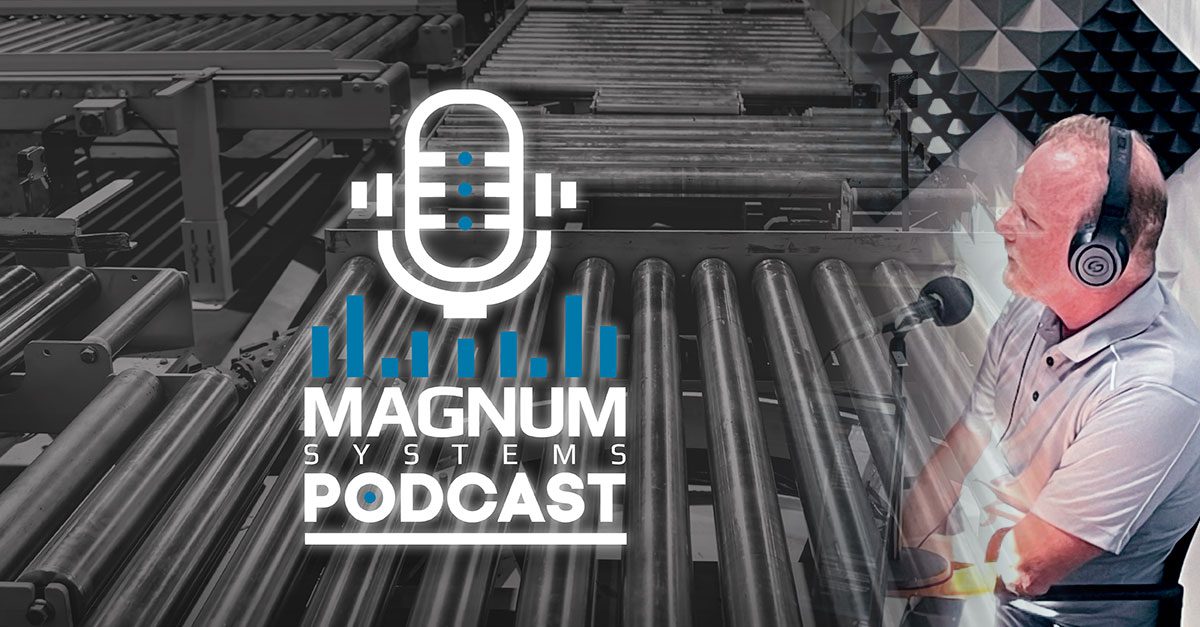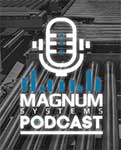

In this episode of Magnum’s podcast, AIM (automate, integrate and manufacture), we delve into the intricate details of pneumatic conveying system design with our guest, Joel Sawalich, Magnum’s special projects manager.
Joel's career in the industry began right after college, launching him into a 34-year-long career in pneumatic conveying. His vast experience covers everything from flow drawings and project management to sales installations and startups. This extensive background gave Joel a unique perspective on the importance of designing and implementing a well-laid-out pneumatic conveying system.
Joel sheds light on the process from understanding where the equipment would be located in the plant to conveying the product to its destination. We discuss the common and severe challenges that can come up in the pneumatic conveying industry and offer cautionary tales, practical tips and solutions. From pipeline blockages and material degradation to segregation, Joel gives us an in-depth understanding of the industry's most pressing problems and potential solutions.
Laying the Groundwork
The layout of a pneumatic conveying system is as crucial as the system itself. It begins with identifying the start and end points within a plant, such as locating equipment for a railcar unloading system or silos. From there, the system must be designed to transport materials to destination vessels and mixers efficiently.
Customer requirements also play a significant role in the layout process. The rate at which clients wish to convey their product dramatically influences how the system is designed. The goal is always to streamline conveyors, avoiding unnecessary distances or elbows that could negatively impact equipment sizing.
"I always want to know where the equipment is going in the building," explains Joel. "This helps me to determine the centerlines of each conveyor and whether or not I need to use curves."
Early Involvement is Key to Overcoming Challenges
Joel stresses the importance of early involvement when asked about the ideal time for a pneumatic conveying company like Magnum Systems to get involved in the design and layout process. This helps avoid potential issues, such as HVAC ducts obstructing the planned conveyance route.
However, even with meticulous planning, unforeseen obstacles can crop up. Other trades may install their equipment first, forcing the pneumatic conveying team to adapt and improvise. Joel emphasizes the need for flexibility and collaboration between all trades to ensure best practices are followed during installation.
One of the challenges Joel recalls is being forced to run a pipe through an HVAC duct, which later led to moisture issues. He stresses the importance of standing your ground in such scenarios, refusing to compromise the system's efficiency or risk potential problems down the line.
Considering Equipment Placement and Proximity
Knowing where equipment will be placed within a building is another critical consideration. There can be logistical challenges when installing large equipment, such as hoppers on higher floors or fitting an eight-foot diameter vessel through a six-foot door. Joel emphasizes the need to think ahead to ensure the system is designed to provide the space in the building.
The location of bulk silos in relation to use points can significantly affect the efficiency of a system. For instance, if silos are placed on the opposite side of the plant from the use points, it could lead to increased system sizing, more extensive equipment and escalated costs. Placing silos closer to use points to streamline operations and reduce expenses significantly benefits the process.
Design Variances Between Food and Industrial Applications
A poorly laid-out system can have a significant impact on system design. The further the distance that needs to be covered, the larger the line size, blower, filters and other components must be. This leads to increased costs and decreased efficiency. Conversely, a well-thought-out, efficient layout can result in lower capital investment.
The design of a system can vary depending on whether it's used for food products or industrial applications. In food processing, there's often a need for a clean room to prevent contamination. This requirement can influence the layout and design of the system. In contrast, industrial applications may not require strict cleanliness standards, allowing for more flexibility in system design.
"Many people have their mixers and all their equipment just out there where everything else is being done," says Joel. "But in food, you need a clean, sterile space or just a process room where you don't have all the outside influences."
Joel and Mike's discussion highlights the importance of careful planning and design in creating an efficient pneumatic conveying system. The system's layout, equipment proximity, and the application's specific needs all play a vital role in shaping the final design. By considering these factors, it's possible to create a system that is both cost-effective and efficient.
Prioritizing Human Safety: Location, Location, Location
Joel emphasized that the placement of equipment is critical when considering explosion mitigation. Equipment should not be in areas with high foot traffic or areas where maintenance and repair are complex, such as placing an airlock eight feet in the air, which might pose challenges for a maintenance worker needing access.
People's safety is a top priority when designing systems with explosion mitigation in mind. There have been instances where explosion panels were meant to exit the building in areas that could harm employees or damage property. Joel points out that one design had an explosion panel exiting near an employee walkway, which could have been disastrous if an explosion had occurred. Another project wanted to vent directly out to liquid oil tanks, which was also flagged as a potential hazard.
A Final Efficient and Streamlined System Layout
As Joel mentions throughout the episode, efficiency is another essential aspect of system design for our customers.
"We want to be as efficient and streamlined as possible, you know, extra elbows in the pneumatic world seem to add to our restrictions," says Joel. "So, it's important to make nice clean lines, trying to make the most efficient system and the most efficient layout."
Safety considerations, particularly about explosion mitigation, can significantly impact system design and layout. From the placement of equipment to the prioritization of human safety and efficiency, these factors can shape a system's final design and effectiveness.
The world of pneumatic conveying is complex, with many factors influencing the design and layout of a successful system. However, with experienced professionals like Joel Sawalich at the helm, Magnum Systems continues to navigate these challenges, offering practical solutions that uphold their commitment to efficiency and customer satisfaction. The key takeaways from this eye-opening discussion are the importance of early involvement in the design process, the need for flexibility and the courage to make the right decisions, even tough ones.
Listen to Joel's podcast episode.


RELATED POSTS
Magnum Systems: Past, Present and Future
You're Not Going to Fill a Juice Glass with a Fire Hose
Pneumatically Speaking in Terms of Efficiency, Compliance & Safety
Packaging Powder, Pellets and Flakes: How Not to Blow It
Automated Packaging Lines: Wringing Out Every Ounce
Related Post
Why Use a Single-Source Systems Integrator Like Magnum Systems?
What Are the Advantages of Dense-Phase Pneumatic Conveying?
Mastering Integration in Manufacturing with Magnum Systems: A Deep Dive Podcast Episode
The Secrets of Valve Bag Sealing: Expert Insights from Magnum Systems